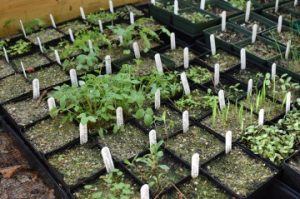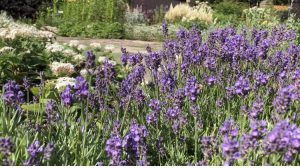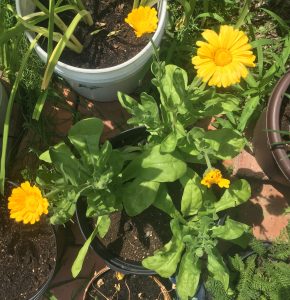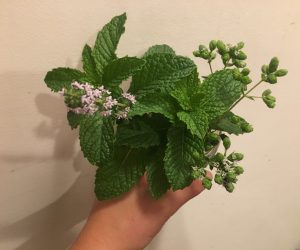Master Gardener Volunteer Newsletter – Hancock County – February 2024
Table of Contents
GETTING TO KNOW MG ADVISORY / MEET PATTY PERSSON / MEET BETSY ADAMS / MEDICINAL HERBS / GET OUTSIDE THIS WINTER! / WORKSHOPS
Upcoming Dates to Remember!
Feb 15 Starting Seeds Indoors (Virtual) Workshop
Feb 19 – Extension Office Closed – HOLIDAY
Mar 4 – MGV Advisory Meeting – Zoom
GETTING TO KNOW OUR MGV ADVISORY MEMBERS!
Happy February!
This month we continue introducing you to members of the Master Gardener Volunteer
Advisory Committee (MGVAC). This month we feature or co/co-chairs (in other words, next
year’s co-chairs) Patty Persson and Betsy Adams. We also welcome a new member to our Newsletter Committee, Nicole Gurreri. This month she has written an article about growing some of her favorite medicinal herbs.
We are always on the lookout for articles you’d like to see here, including anything you would
like to write. Contact us at MGVnewsletterinput@gmail.com.
Getting to Know Patty Persson

Hats off to all the Master Gardener Volunteers out there.
Our happy space under the bright sun with our hands
in the warm soil is just around the corner or two.
We can do this!
For years my winter world was encircled in blossoms of bright yellow hibiscus, cream
colored southern magnolia, fragrant citrus, velvety white gardenia, purple azalea, red
plumeria, fuchsia bougainvillea, Clerodendrum, star jasmine, Ixora, 8 ft tall amazon
lilies, torch gingers and coconut palms. I treasured my time under the live oaks dripping
with Spanish moss to weed the flower beds filled with bromeliads, 7 ft tall philodendron,
Thai plants, crotons, schefflera, variegated Pittosporum, geraniums, orchids, and ferns.
Sigh…
We retired to Maine in the spring of 2017. Two immediate observations were one, that
judging by the white powdered lawn I would no longer need my Stokes Tropical Garden
catalog! And two, I better learn as quickly as possible about growing in Maine (me
included).
From a brief stay at the Blue Hill Inn while our 200-year-old farmhouse was getting a
floor makeover I learned that living in Maine is a Team effort. Everyone is encouraged to
pitch in during the summer so that the local business can survive the slower seasons of
winter and “mud”.
With my new resolve to throw down deep roots, connect with my new community, and
to blossom like a dandelion, I got a job at Mainescape, began an ambitious home
landscape expansion, studied up on biodynamic gardening, and three years later
enrolled in the MGV program. Through my volunteer hours at Brooklin Community
Garden, Loaves and Fishes, and with the Master Gardener Volunteer Action Committee I
learned we are never truly finished with the work, and that’s okay. In the garden, there’s
always something new to learn, and friendships, like plants thrive from attention,
intention, and loving care.
Working with this dedicated group of health-conscientious, earth-friendly, community
leaders in the preservation of environmental harmony is one of the greatest choices I’ve
made. Thank you, Master Gardener Volunteers, for keeping the momentum growing!
During these winter days please join me on the tennis court, at the Mahjongg table, or
out on the trails walking with our 6-month-old Landseer/Great Pyrenees mix, Sir
Benchley. As gardening inevitably comes up during all activities, we’ll have plenty to
talk about.
Getting to Know Betsy Adams

I am proud to be a member of the Advisory Committee. This is my second year, and my first as the coordinator of the newsletter. I live in Surry on a small property with a lot of shade and a lot of wind. I have six small raised beds in my patch of sun and grow herbs in one, and a rotating selection of vegetables and pollinators in the others. I am adding more natives around the property and slowly reducing our lawn. This year I’m going to install a native and pollinator bed which I prepped last summer and is covered with a thick layer of maple chips to kill the grass and weeds. I have a few young shrubs planted in other beds for the winter and will transplant them to the new garden in the Spring. I’m also trying winter sowing. I’ll let you know how that goes! My life as a gardener has been a joy and a constant exercise in trial and error. MGV has helped me make some better choices, but I’m always at the mercy of Mother Nature and the occasional misguided choice.
I have been volunteering at the Extension Office and Native Gardens of Blue Hill since I started the MGV program in 2021 and I love both of them and the community I’ve found there. I have recently joined the Board at Native Gardens.
I have visited and lived in Maine on and off since 1989, and my husband and I have been here full-time since Covid. I spent my career as a Theatrical Lighting Designer based in NYC, working in New York and other cities around the country plus designing a few shows in other countries. I loved what I did, but I spent that part of my life literally in the dark. I couldn’t be happier to live in the light, even in the winter.
Add Medicinal Herbs to Your 2024 Garden!
By Nicole Gurreri, MGV
Winter is a special season for Maine gardeners – cold, snowy days are the perfect time
to peruse seed catalogs and find new plants for your garden. This year, consider adding easy-to-grow medicinal herbs to your garden plan! Many medicinal herbs are easy to grow and harvest, and can be processed into healing teas, tinctures, and salves.
Why Grow Medicinal Herbs
If you’ve never grown medicinal herbs before, you might hesitate to give these plants
precious garden real-estate. Just like the vegetables in your garden, however, medicinal
herbs are beneficial to both ecological and personal health. Plants like calendula,
chamomile, and yarrow offer long-blooming flowers that attract a wide range of
pollinators and beneficial insects. Many medicinal herbs have essential oils which repel
unwanted garden visitors like mosquitoes and rabbits. Other plants (like stinging nettle)
make a nutrient-rich compost at the end of the season.
For your personal and family health, medicinal herbs can be processed into a wide
variety of healing teas, tinctures, and salves. Many of the herbs recommended below
can be used safely to calm anxiety, ease upset stomachs, and add vitamins and
minerals to your diet. Even the gentle scent of lavender and lemon balm plants can lend
a feeling of tranquility to your time in the garden.
If you’re still unsure about adding these healing plants into your beds, any of the herbs
recommended below can be grown in pots, window boxes, or other containers.
Seven Easy-to-Grow Medicinal Herbs
When you’re ready to add a few medicinal herbs into your garden, start with some low-
maintenance plants that are enjoyable to grow. My top suggestions for easy-to-grow
medicinal herbs are:
1. Calendula (Calendula officinalis)
Calendula is a cheery, prolifically blooming annual flower that will attract
pollinators to your garden plot. Direct seed calendula after the last frost
date and you will be rewarded with a bounty of orange-yellow flowers all
season long! Deadheading throughout the season encourages extended
bloom time. They re-seed and you will have many volunteers next year to
share with friends.
2. Yarrow (Achillea millefolium)
Yarrow is a native perennial plant revered for its ability to slow bleeding and heal wounds. I find it easiest to grow yarrow from a plug or nursery pot – transplants can be found at many local nurseries. Avoid purchasing
cultivars (such as Achillea “Moonshine”) – for the most medicinal value, you want the straight-species Achillea millefolium, which has white flowers.
3. Lavender (Lavandula angustifolia)
Lavender is a familiar perennial that thrives in drier, well-drained soils. Look for the straight species of this plant at many local nurseries, and transplant it outdoors as soon as the danger of frost has passed. Dried lavender
blossoms are an excellent addition to a bedtime tea blend, or a relaxing bath soak.
4. Chamomile (Matricaria chamomilla)
Chamomile is a fragrant herb that bears hundreds of tiny flowers throughout the summer. When dried, these flowers make a sweet tea that calms both the mind and body. Chamomile can be directly sown after the last frost, or started indoors 6-8 weeks before the last frost date. This plant self-seeds easily, so take care to plant it somewhere that can stand a little “wandering” chamomile!
5. Lemon Balm (Melissa officinalis)
Lemon balm is a member of the mint family, and thus should be planted in a container to avoid aggressive spreading. This wonderfully-scented plant is calming and uplifting, and makes a great addition to a tea or salve. Lemon balm can be started from seed 6-8 weeks before the last frost, or starts can be purchased from local nurseries.
6. Spearmint (Mentha spicata) or Wild Mint (Mentha arvensis)
Spearmint or wild mint are eager perennial plants that make flavorful teas! As with all members of the mint family, these mints should be planted in a container to avoid aggressive spreading. Mint seedlings can be started indoors 8 weeks before the last frost date; I have also had success finding Mentha spicata plants at local nurseries.
7. Stinging Nettle (Urtica dioica)
Stinging nettle is a native perennial plant famous for its prickly hairs which
provoke a burning sensation and accompanying rash. This plant, however,
is full of vitamins and minerals and is perfectly safe to ingest once the
leaves are pulverized, dried, or cooked! Add dried leaves to a tea blend for
a boost of iron. Another mint family member, stinging nettle should be
planted with care as it is an aggressive spreader. Stinging nettle can be
direct-sown in early spring.
- Lavendula angustifolia
- Calendula in Container
- Spearmint-oregano bundle
Further Reading on Growing Medicinal Herbs
Chestnut School of Herbal Medicine – Guidelines to Growing Medicinal Herbs
from Seed
Get Outside this Winter
by Betsy Adams
It’s an undeniable pleasure to curl up in front of the fire and enjoy the quiet of winter here and
dream of next summer’s garden; but it’s good for body and soul to take some time out-of-
doors. If you need some encouragement or inspiration, think about taking the Winter Hiking
Challenge co-sponsored by the Blue Hill Heritage Trust and the Blue Hill Library. It continues
until March 19, the first day of Spring. You can pick up a checklist at the Blue Hill Library or
email: claire.malina@bhpl.net to have a PDF sent to you.
The challenge includes all of the following trails:
Parker Point to South Street, Blue Hill
Penny’s Preserve, Blue Hill
Hundred Acre Wood, Brooklin
John B. Mountain, Brooksville
Wallamatogus, Penobscot
Caterpillar Hill, Sedgwick
Bluff Head Trail, Sedgwick
Snow’s Cove, Sedgwick
Surry Forest, Surry.
Maps for the trails can be found at bluehillheritagetrust.org/trails/. There is a sign posted at
each of the designated trails and a mystery letter for participants to collect. Hikers will learn
about the different trees that can be found around the peninsula, their specific characteristics and
how to identify them.
Once you have completed all nine trails and assembled the letters to form the mystery word,
bring the completed card to the library to receive a prize. Everyone will receive a prize for
completing the hiking challenge and there will be a prize drawing for adults.
I’ve done three so far and had a great time. Each time included at least one fellow MGV. Grab a
friend, or several, layer up and bring some water and – a personal suggestion – your ice cleats
and trekking poles – and have fun.
Betsy Adams
Upcoming Workshops
Starting Seeds Indoors Workshop (virtual) February 15, 2024
Learn best practices for growing seedlings indoors. Participants will learn how to develop a personalized seed starting calendar based on Maine weather conditions and hear practical tips for the small-scale home gardener. Pre-registration is required. A recording will be shared with anyone who pre-registers for this event.
calendar based on Maine weather conditions and hear practical tips for the small-scale home gardener. Pre-registration is required. A recording will be shared with anyone who pre-registers for this event.
Presented by Kate Garland, Horticulture Professional with the University of Maine Cooperative Extension.
When: February 15, 2024
Time: 6:00 p.m. – 7:30 p.m.
Location: Virtual
Save the Date!
2- Part Pruning Workshop Offered
Introduction to Pruning Landscape Trees, Flowering Shrubs and Small Fruits
This hands-on pruning workshop will be offered on
This is a Save the Date only – Registration Details will be shared widely when available.
DO YOU KNOW
-Someone who inspires your gardening?
-Someone who is making a difference environmentally, food security, climate change mitigation – whether quietly
or loudly in one small plot or a large project? IF SO – We want to know, here is one way to tell us
MGVnewsletterinput@gmail.com
Our MGV newsletter is for and about Washington/Hancock MGV people, projects, and the community. MGVnewsletterinput@gmail.com, was established as a way for readers to recommend interesting topics or people for future articles, provide comments, or ask questions. It has been a little used resource, but for some of you, it has been a way to not only give input to the newsletter committee but also to make suggestions for Continuing Education and MGV projects. Try it!
This month’s newsletter sent by Sue includes articles from our new “Communicate with MGV’s” task force. We’d like the next edition to feature your suggestions and articles about gardeners and gardens. MGV’s, please contact us at MGVnewsletterinput@gmail.com with your ideas.
Thank you from
Betsy Adams, Jan M., Jane, Linda, Mary D., Mary H., and Nicole!



